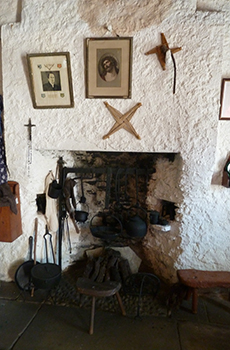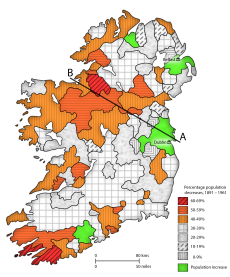👉 Find out about The Open University's Geography courses. 👈
 Glencolmcille folk village, 2015
Glencolmcille folk village, 2015
One of the main motives behind the continued development of local industries in Southwest Donegal over the last thirty years has been the maintenance of an Irish-speaking community. The development has, in turn, put further pressure on the Irish language, and English has now become the dominant means of communication over most of what is officially an Irish-speaking area. On the other hand, development, combined with the decreasing job opportunities both overseas and elsewhere in Ireland, stemmed the flow of emigration and the local population increased for the first time in living memory.
 Inside a cottage at the folk village
The Glencolmcille Folk Village - established by Fr McDyer, as we saw in 'The dilemma of tourism and the Irish language, 1983' - is still an important and popular tourist attraction, with about 40,000 visitors annually. While it offers a unique attraction founded on the local culture and heritage, in 2015 many linkages are made which demonstrate the area’s on-going interdependence with the outside world. Glencolmcille is depicted as the location where Bonny Prince Charlie took refuge after the battle of Culloden and where American painter Rockwell Kent, Welsh poet Dylan Thomas and British composer Arnold Bax lived and found inspiration. The unique layers of history and culture make this an attractive destination, which depends on visitors who are increasingly attracted through marketing on Facebook, Twitter and Tripadvisor.
Inside a cottage at the folk village
The Glencolmcille Folk Village - established by Fr McDyer, as we saw in 'The dilemma of tourism and the Irish language, 1983' - is still an important and popular tourist attraction, with about 40,000 visitors annually. While it offers a unique attraction founded on the local culture and heritage, in 2015 many linkages are made which demonstrate the area’s on-going interdependence with the outside world. Glencolmcille is depicted as the location where Bonny Prince Charlie took refuge after the battle of Culloden and where American painter Rockwell Kent, Welsh poet Dylan Thomas and British composer Arnold Bax lived and found inspiration. The unique layers of history and culture make this an attractive destination, which depends on visitors who are increasingly attracted through marketing on Facebook, Twitter and Tripadvisor.
In 1983 the dilemma of undertaking development in order to retain population in the area, was recognised as risking eroding the local culture and language. In 'The dilemma of tourism and the Irish language, 1983' Father McDyer had argued that lack of development was not an option, resulting in ‘an Indian Reservation’ with no development and no people.
 A recent report commissioned by Údarás na Gaeltachta published in May 2015 suggested that Irish (Gaeilge) will no longer be the primary language in any Gaeltacht community in ten years (Ó Giollagáin and Charlton, 2015; RTE, 2015). Using census figures from 2006 and 2011, it found that spoken Irish in the Gaeltacht - areas where the bulk of the population speak the language - is becoming confined to academic settings, with social use of Irish declining at a rapid rate. Of the 155 electoral divisions in the Gaeltacht, only 21 are communities where Irish is spoken on a daily basis by 67% or more of the population. Combining the numbers claiming to speak Irish daily both inside and outside of education, just 40% of the population of Southwest Donegal fulfil this requirement (2011 census data: 703 of 1758 people - Central Statistics Office, 2011).
A recent report commissioned by Údarás na Gaeltachta published in May 2015 suggested that Irish (Gaeilge) will no longer be the primary language in any Gaeltacht community in ten years (Ó Giollagáin and Charlton, 2015; RTE, 2015). Using census figures from 2006 and 2011, it found that spoken Irish in the Gaeltacht - areas where the bulk of the population speak the language - is becoming confined to academic settings, with social use of Irish declining at a rapid rate. Of the 155 electoral divisions in the Gaeltacht, only 21 are communities where Irish is spoken on a daily basis by 67% or more of the population. Combining the numbers claiming to speak Irish daily both inside and outside of education, just 40% of the population of Southwest Donegal fulfil this requirement (2011 census data: 703 of 1758 people - Central Statistics Office, 2011).
The uniqueness of the Irish language, although under threat, can be seen as an important resource for the area. Oideas Gael, an organisation offering adult Irish language and cultural courses, attracts participants from around the world to Southwest Donegal.
Liam Ó Cuinneagáin, one of the founders of Oideas Gael, discusses the shift in language usage in the area in a conversation with Cillian Mac Gabhann.
When interviewed for this article in 2015, Liam Ó Cuinneagáin wrote:
"Bhí an Ghaeilge in gach uile áit thart orm agus mé ag fás aníos sa Ghleann insna caogaidí. Tháinig athruithe móra laistigh de thríocha bliain i ndiaidh sin, sa dóigh gur bheartaigh mé féin agus an Dr Seosamh Watson tionscnamh a bhunú le hiarracht a dhéanamh moill a chur ar an chreimeadh teanga. I 1984, nuair a thosaigh Oideas Gael, thiocfadh linn siúl trasna an bhealaigh go Tigh Bhiddy agus gan ach Gaeilge a chluinstin ón fhoireann agus ón chuideachta ann. Sa lá inniu (2015) tá an tírdreach teanga imithe as a riocht go hiomlán seachas mar a bhí. Níl ach cupla teaglach lóistín anois le hais an dosaein a bhí againn nuair a thosaigh muid. Níl Gaeilge le cluinstin ag páistí i gclós na scoile ná sa bhaile níos mó. Bhí an-tionchar ag Oideas Gael ar an phobal riamh, mar atá i gcónaí, ó thaobh na heacnamaíochta de agus is togra thar a bheith fiúntach don phobal é. Ar an drochuair, caithfimid a admháil nár éirigh linn an creimeadh teanga a chur ina stad, bíodh go mb'fhéidir gur chuir moill bheag air -- is doiligh a rá."
"For me as a child growing up in The Glen during the fifties, Irish was the dominant language and spoken by 60% of the community. In 1984 when Dr Seosamh Watson and myself established Oideas Gael, the shift in language usage meant that those over fifty were the main users; Biddy’s Bar was directly across from the school and most of its clientele spoke Irish as a matter of course. Now, thirty years later (2015) the language landscape has changed dramatically. Children no longer play in Irish during playtime at school; our host families have reduced from twelve families to four and the English language is spoken daily by over 90% of the population. Oideas Gael is a strong force in the area, both economically and socially but, all in all, it is clear that reversing language decline is a particularly difficult challenge once the tipping point in the process has been reached."












Rate and Review
Rate this video
Review this video
Log into OpenLearn to leave reviews and join in the conversation.
Video reviews